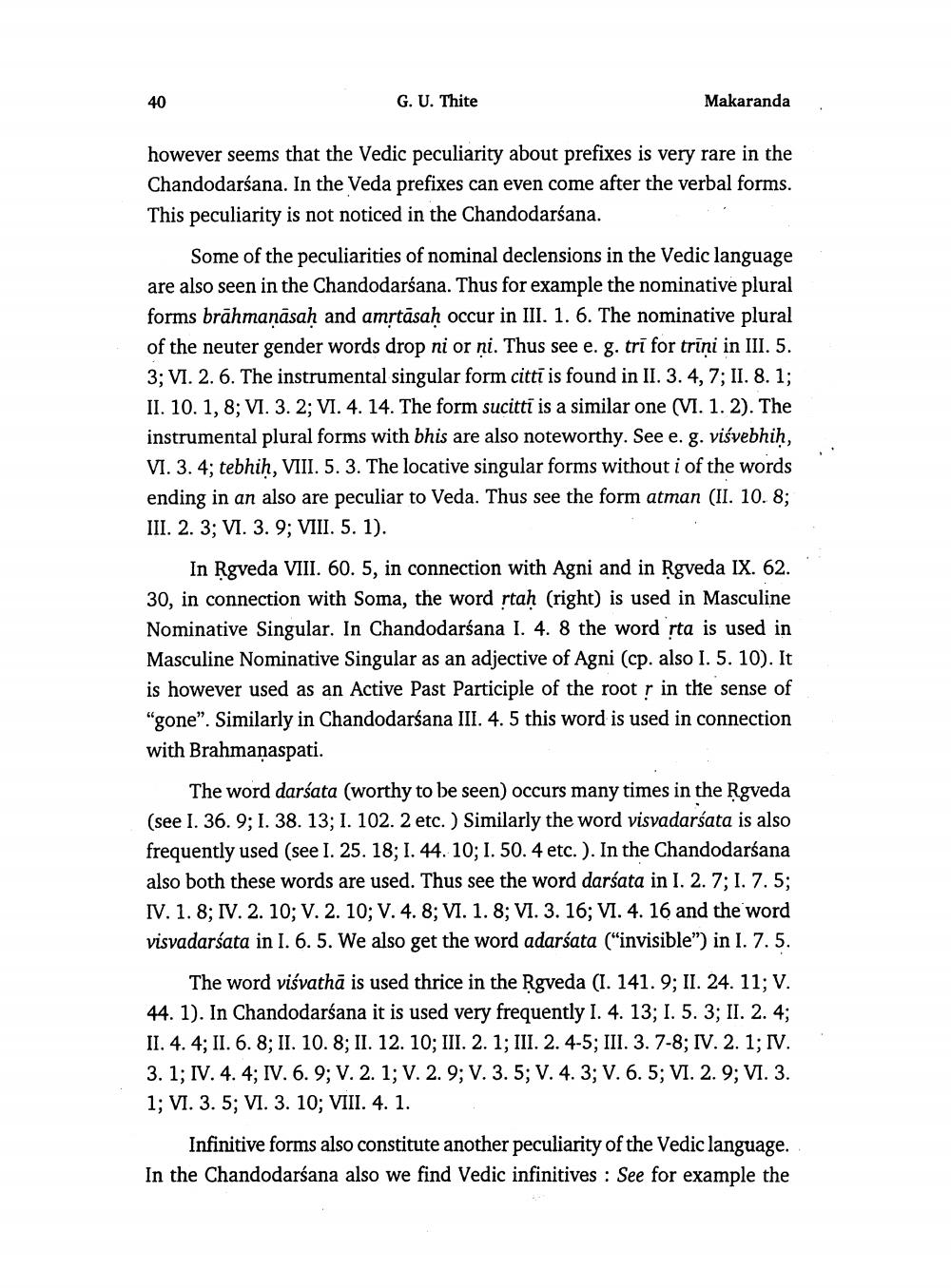________________
G. U. Thite
Makaranda
however seems that the Vedic peculiarity about prefixes is very rare in the Chandodarśana. In the Veda prefixes can even come after the verbal forms. This peculiarity is not noticed in the Chandodarśana.
Some of the peculiarities of nominal declensions in the Vedic language are also seen in the Chandodarsana. Thus for example the nominative plural forms brāhmaṇāsah and amrtāsaḥ occur in III. 1. 6. The nominative plural of the neuter gender words drop ni or ni. Thus see e. g. trī for trīni in III. 5. 3; VI. 2. 6. The instrumental singular form citti is found in II. 3. 4, 7; II. 8. 1; II. 10.1, 8; VI. 3. 2; VI. 4. 14. The form sucitti is a similar one (VI. 1. 2). The instrumental plural forms with bhis are also noteworthy. See e. g. viśvebhih, VI. 3. 4; tebhih, VIII. 5. 3. The locative singular forms without i of the words ending in an also are peculiar to Veda. Thus see the form atman (II. 10.8; III. 2. 3; VI. 3. 9; VIII. 5. 1).
In Rgveda VIII. 60.5, in connection with Agni and in Rgveda IX. 62. 30, in connection with Soma, the word stah (right) is used in Masculine Nominative Singular. In Chandodarśana I. 4. 8 the word rta is used in Masculine Nominative Singular as an adjective of Agni (cp. also I. 5. 10). It is however used as an Active Past Participle of the root r in the sense of "gone". Similarly in Chandodarśana III. 4. 5 this word is used in connection with Brahmanaspati.
The word darbata (worthy to be seen) occurs many times in the Rgveda (see I. 36. 9; 1. 38. 13; 1. 102. 2 etc. ) Similarly the word visvadarśata is also frequently used (see I. 25. 18; 1. 44.10; I. 50.4 etc.). In the Chandodarśana also both these words are used. Thus see the word darśata in I. 2. 7; I. 7.5; IV. 1. 8; IV. 2. 10; V. 2. 10; V. 4.8; VI. 1. 8; VI. 3. 16; VI. 4. 16 and the word visvadarśata in I. 6. 5. We also get the word adarśata ("invisible") in I. 7.5.
The word viśvathā is used thrice in the Rgveda (I. 141. 9; II. 24. 11; V. 44. 1). In Chandodarśana it is used very frequently I. 4. 13; 1. 5. 3; II. 2. 4; II. 4. 4; II. 6. 8; II. 10. 8; II. 12. 10; III. 2. 1; III. 2. 4-5; III. 3. 7-8; IV. 2. 1; IV. 3. 1; IV. 4. 4; IV. 6. 9; V. 2. 1; V. 2. 9; V. 3. 5; V. 4. 3; V. 6.5; VI. 2. 9; VI. 3. 1; VI. 3. 5; VI. 3. 10; VIII. 4. 1.
Infinitive forms also constitute another peculiarity of the Vedic language. In the Chandodarśana also we find Vedic infinitives : See for example the




